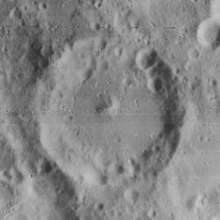Rheita (crater)
Rheita is a lunar impact crater located in the southwestern sector of the Moon. It was named after Czech astronomer and optician Anton Maria Schyrleus of Rheita.[1] It lies to the northeast of the crater Metius, and northwest of Young. The southwestern rim overlies the edge of Vallis Rheita, a long lunar valley stretching for over 200 kilometers on a line running northeast to southwest. At its widest the valley is 25 kilometers wide and a kilometer deep.
 LRO mosaic | |
| Coordinates | 37.1°S 47.2°E |
|---|---|
| Diameter | 70 km |
| Depth | 4.3 km |
| Colongitude | 314° at sunrise |
| Eponym | Anton M. S. of Rheita |

The rim of Rheita remains well-defined with a sharp lip and a terraced inner wall. The rim overlaps a slightly smaller crater to the east, and has a pair of small impact craters in the northern wall. The crater floor is flat and it has a central peak.
Satellite craters
By convention these features are identified on lunar maps by placing the letter on the side of the crater midpoint that is closest to Rheita. It has overlapping craters.
| Rheita | Latitude | Longitude | Diameter |
|---|---|---|---|
| A | 38.0° S | 50.0° E | 11 km |
| B | 39.1° S | 52.8° E | 21 km |
| C | 35.1° S | 44.2° E | 8 km |
| D | 39.1° S | 50.1° E | 6 km |
| E | 34.2° S | 49.1° E | 66 x 32 km |
| F | 35.4° S | 48.4° E | 14 km |
| G | 40.5° S | 54.3° E | 15 km |
| H | 39.8° S | 51.7° E | 7 km |
| L | 37.7° S | 52.9° E | 10 km |
| M | 35.5° S | 50.1° E | 25 km |
| N | 35.1° S | 49.5° E | 8 km |
| P | 37.9° S | 44.4° E | 11 km |
References
- "Rheita (crater)". Gazetteer of Planetary Nomenclature. USGS Astrogeology Research Program.
- Andersson, L. E.; Whitaker, E. A. (1982). NASA Catalogue of Lunar Nomenclature. NASA RP-1097.CS1 maint: ref=harv (link)
- Bussey, B.; Spudis, P. (2004). The Clementine Atlas of the Moon. New York: Cambridge University Press. ISBN 978-0-521-81528-4.CS1 maint: ref=harv (link)
- Cocks, Elijah E.; Cocks, Josiah C. (1995). Who's Who on the Moon: A Biographical Dictionary of Lunar Nomenclature. Tudor Publishers. ISBN 978-0-936389-27-1.CS1 maint: ref=harv (link)
- McDowell, Jonathan (July 15, 2007). "Lunar Nomenclature". Jonathan's Space Report. Retrieved 2007-10-24.CS1 maint: ref=harv (link)
- Menzel, D. H.; Minnaert, M.; Levin, B.; Dollfus, A.; Bell, B. (1971). "Report on Lunar Nomenclature by the Working Group of Commission 17 of the IAU". Space Science Reviews. 12 (2): 136–186. Bibcode:1971SSRv...12..136M. doi:10.1007/BF00171763.CS1 maint: ref=harv (link)
- Moore, Patrick (2001). On the Moon. Sterling Publishing Co. ISBN 978-0-304-35469-6.CS1 maint: ref=harv (link)
- Price, Fred W. (1988). The Moon Observer's Handbook. Cambridge University Press. ISBN 978-0-521-33500-3.CS1 maint: ref=harv (link)
- Rükl, Antonín (1990). Atlas of the Moon. Kalmbach Books. ISBN 978-0-913135-17-4.CS1 maint: ref=harv (link)
- Webb, Rev. T. W. (1962). Celestial Objects for Common Telescopes (6th revised ed.). Dover. ISBN 978-0-486-20917-3.CS1 maint: ref=harv (link)
- Whitaker, Ewen A. (1999). Mapping and Naming the Moon. Cambridge University Press. ISBN 978-0-521-62248-6.CS1 maint: ref=harv (link)
- Wlasuk, Peter T. (2000). Observing the Moon. Springer. ISBN 978-1-85233-193-1.CS1 maint: ref=harv (link)
| Wikimedia Commons has media related to Rheita (crater). |